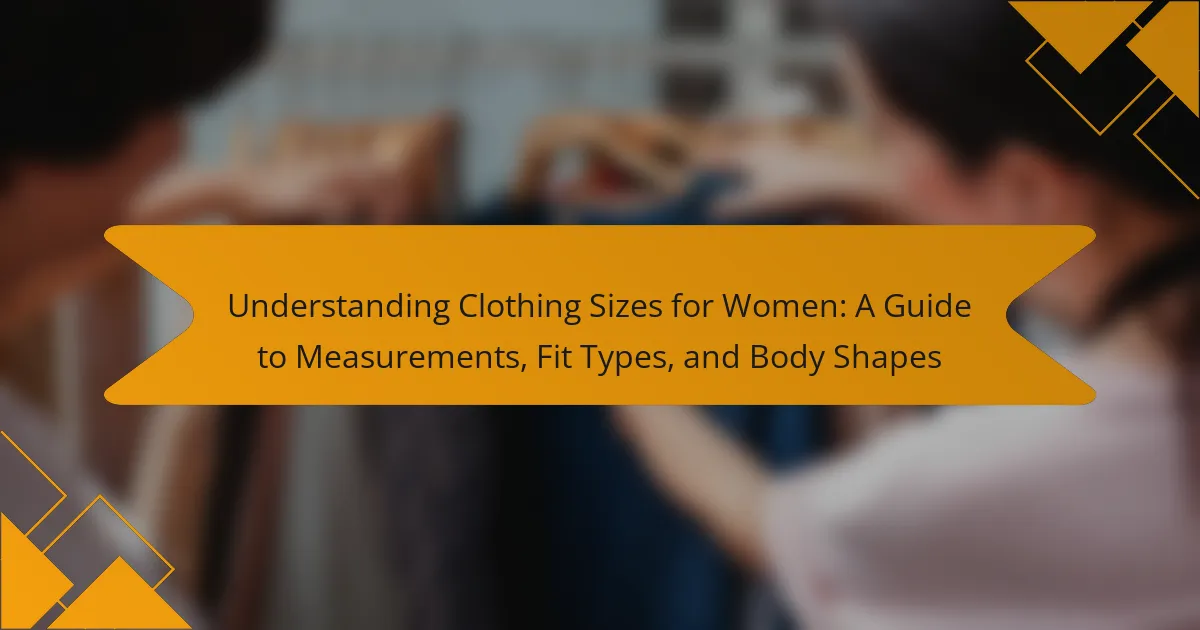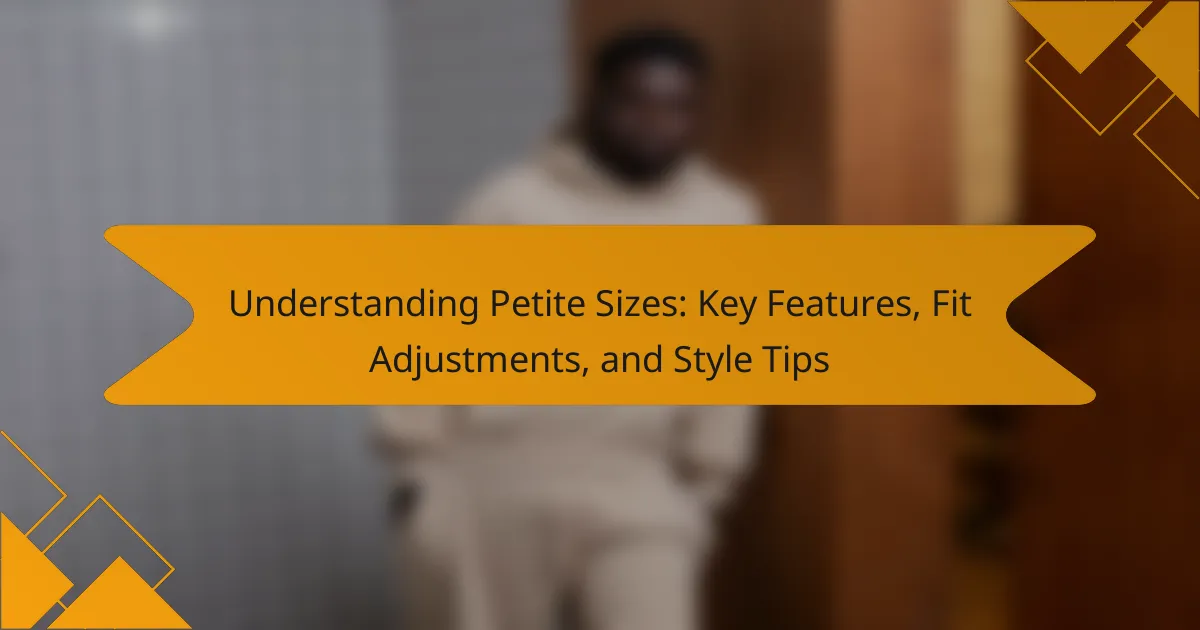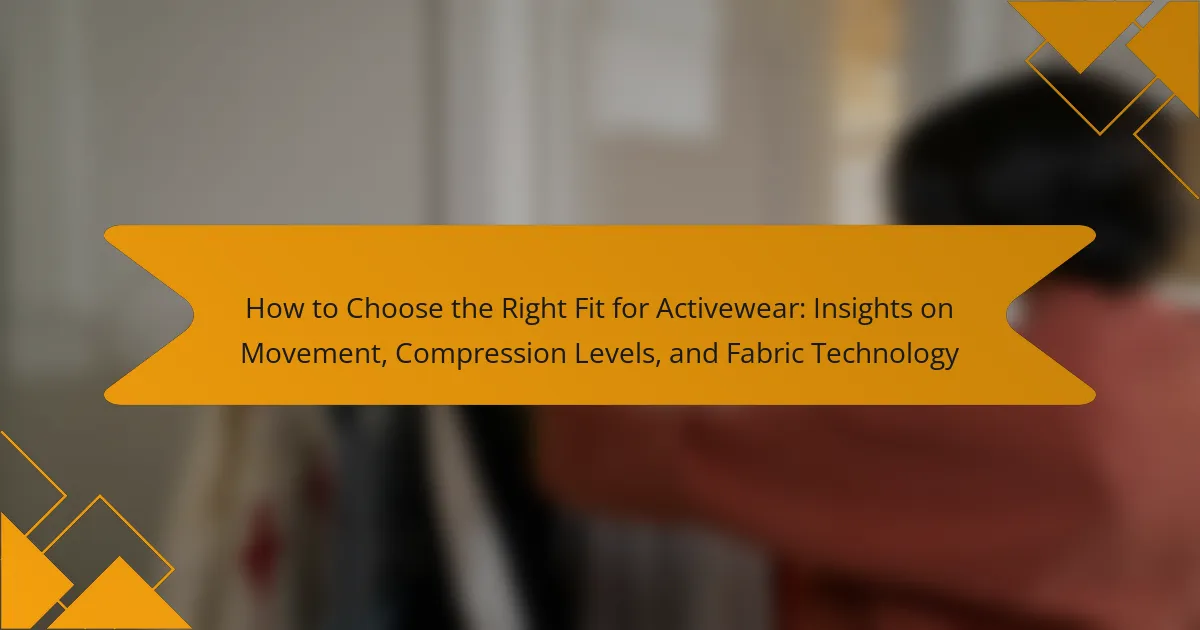Understanding clothing sizes for women involves navigating various sizing systems, including numerical sizes (0-16) and letter sizes (XS-XL), which correspond to body measurements. The article explores different clothing fits such as tailored, relaxed, loose, and fitted, each catering to different style preferences and body types. Accurate measurement techniques are outlined to ensure a proper fit, considering factors like bust, waist, hips, inseam, and sleeve length. Additionally, the impact of body shapes—such as hourglass, pear, and apple—on clothing sizing is discussed, highlighting the importance of selecting garments that enhance individual silhouettes. The article emphasizes the prevalence of size inconsistency across brands and the need for women to consult specific sizing charts for the best fit.
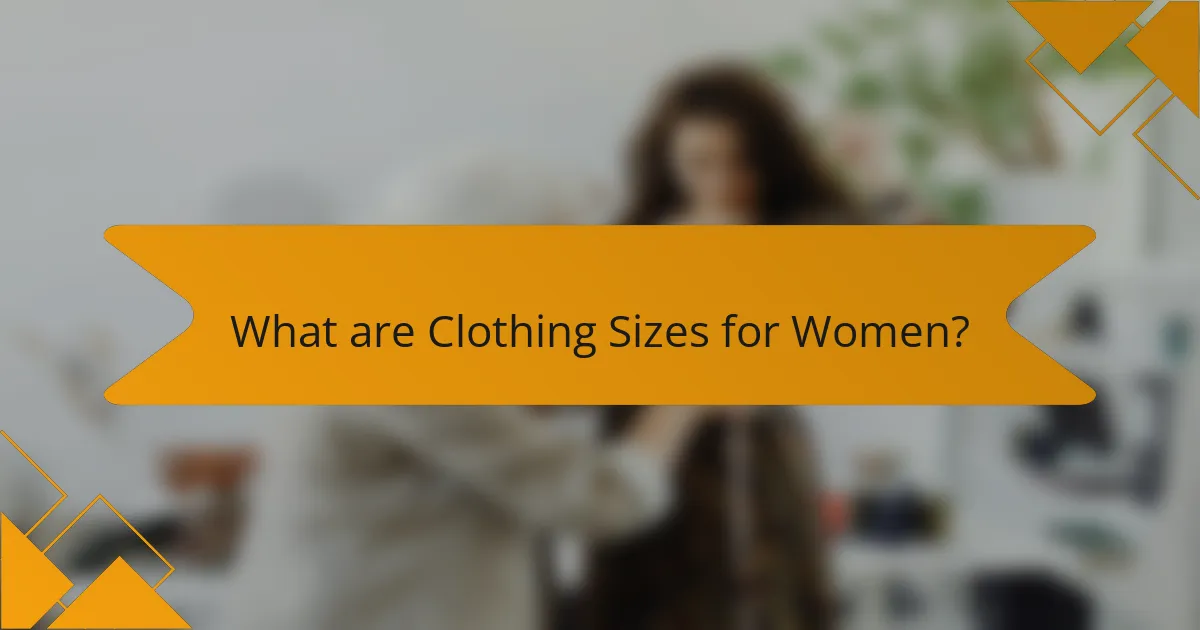
What are Clothing Sizes for Women?
Clothing sizes for women vary by brand and region. Common sizing systems include numerical sizes (e.g., 0-16) and letter sizes (e.g., XS-XL). The numerical system typically corresponds to body measurements in inches. For example, a size 8 usually fits a bust measurement of 36 inches, a waist of 28 inches, and hips of 38 inches. Letter sizes often reflect a range of measurements. The standard size chart provides guidelines, but actual fit may differ. Size inconsistency exists across different brands. Women should refer to specific sizing charts for accurate fit.
How are women’s clothing sizes determined?
Women’s clothing sizes are determined based on a combination of body measurements, fit standards, and manufacturing specifications. Standard sizing typically includes measurements for bust, waist, and hips. These measurements are taken in inches or centimeters. Various sizing systems exist, including numerical sizes and letter sizes (S, M, L). The sizing can vary significantly between brands and regions. For example, a size 8 in one brand may differ from a size 8 in another. Additionally, fashion trends can influence sizing standards over time. Historically, the American National Standards Institute (ANSI) established guidelines for women’s sizes in the 1970s. However, many brands now create their own size charts, leading to inconsistencies.
What measurements are essential for sizing?
Essential measurements for sizing women’s clothing include bust, waist, and hip measurements. The bust measurement is taken around the fullest part of the chest. The waist measurement is taken at the natural waistline, typically above the belly button. The hip measurement is taken around the fullest part of the hips. Additionally, inseam and sleeve length can be important for specific garments. Accurate measurements ensure a better fit and enhance comfort. According to the American Society for Testing and Materials, proper sizing can significantly improve garment satisfaction and reduce returns.
How do sizing standards vary across brands?
Sizing standards vary across brands due to differences in measurement systems and target demographics. Each brand may use unique sizing charts that reflect their design philosophy and intended fit. For example, a size 8 in one brand may correspond to a size 6 in another. Brands may also have varying tolerances for size deviations, leading to inconsistencies. Additionally, factors such as regional sizing norms, fabric types, and style influences can impact how sizes are defined. This lack of standardization creates challenges for consumers when selecting clothing. Studies indicate that up to 80% of women wear the wrong size due to these discrepancies.
Why is understanding clothing sizes important?
Understanding clothing sizes is important because it ensures a proper fit. A proper fit enhances comfort and confidence in clothing choices. Clothing sizes vary significantly across brands and regions. This inconsistency can lead to confusion when shopping. Knowing your measurements helps in selecting the right size. Accurate sizing reduces the likelihood of returns and exchanges. According to a study by the American Society of Testing and Materials, incorrect sizing is a leading cause of online return rates. Understanding clothing sizes ultimately saves time and money for consumers.
How does proper sizing affect comfort and fit?
Proper sizing directly influences comfort and fit in clothing. When garments are sized correctly, they align with the body’s dimensions. This alignment reduces restrictions in movement. It also minimizes discomfort caused by tight or loose clothing. Properly sized clothing allows for better airflow and temperature regulation. Studies show that well-fitted clothing enhances overall satisfaction with the garment. For instance, a survey by the Journal of Fashion Marketing and Management indicated that 70% of women prioritize fit when purchasing clothing. Therefore, correct sizing is essential for both comfort and a flattering appearance.
What impact does sizing have on body confidence?
Sizing significantly impacts body confidence. When clothing sizes do not align with a person’s body shape, it can lead to negative self-perception. Research shows that individuals often associate smaller sizes with attractiveness and success. According to a study published in the Journal of Fashion Marketing and Management, many women report feeling more confident when they wear clothes that fit well and are true to size. Conversely, ill-fitting clothing can heighten feelings of insecurity and dissatisfaction with one’s body. This correlation between sizing and body confidence is critical in understanding how clothing affects self-esteem.

What are the Different Types of Clothing Fits?
The different types of clothing fits include tailored, relaxed, loose, and fitted. Tailored fit is designed to follow the body’s shape closely. Relaxed fit allows for more movement and comfort. Loose fit provides a baggier silhouette, often used in casual wear. Fitted clothing hugs the body closely, emphasizing shape. Each fit type serves different style preferences and body types. Understanding these fits helps in choosing the right clothing for individual needs.
What are the common fit types for women’s clothing?
The common fit types for women’s clothing include regular, slim, relaxed, and oversized. Regular fit is designed to provide a standard silhouette that accommodates most body shapes. Slim fit offers a more tailored look, often hugging the body closely. Relaxed fit provides extra room, allowing for comfort and ease of movement. Oversized fit is intentionally larger, creating a loose and casual appearance. These fit types cater to various preferences and body types, ensuring a wide range of options for consumers.
How does a relaxed fit differ from a fitted style?
A relaxed fit offers a looser silhouette compared to a fitted style, which hugs the body’s contours. Relaxed fit garments provide extra room in the bust, waist, and hips. This design allows for greater comfort and ease of movement. In contrast, fitted styles are tailored to closely follow the body’s shape. They often emphasize the waist and create a more structured appearance. The distinction is essential for choosing clothing based on comfort or style preferences. Relaxed fits are commonly found in casual wear, while fitted styles are prevalent in formal attire.
What are the characteristics of a tailored fit?
A tailored fit is characterized by a precise and customized silhouette. It is designed to contour to the body’s natural shape. This fit often features narrower shoulders and a tapered waist. Tailored fit garments typically use high-quality materials for structure. They provide a polished appearance suitable for formal occasions. The construction involves careful measurements to ensure comfort and mobility. Tailored fit is distinct from loose or oversized styles. This fit enhances the wearer’s figure while allowing for ease of movement.
How do fit types affect clothing selection?
Fit types significantly influence clothing selection by determining how garments conform to the body. Various fit types include slim, regular, and loose fits. Each fit type caters to different body shapes and personal preferences. For instance, slim fit is tailored closely to the body, enhancing a streamlined appearance. Regular fit provides a balanced silhouette, suitable for everyday wear. Loose fit offers comfort and breathability, ideal for casual outfits. Understanding these fit types helps individuals select clothing that flatters their body shape and aligns with their style goals. Accurate measurements and fit preferences guide effective clothing choices, ensuring satisfaction with the selected garments.
What considerations should be made for different body shapes?
Different body shapes require specific considerations in clothing design and fit. Body shapes can include apple, pear, hourglass, and rectangle. Each shape has unique proportions that influence garment selection. For example, apple shapes may benefit from styles that create a waistline. Pear shapes often look better in A-line skirts that balance wider hips. Hourglass shapes can opt for fitted clothing that accentuates curves. Rectangle shapes might choose clothing that adds curves or definition. Consideration of these shapes can enhance comfort and style. Understanding these distinctions leads to better clothing choices for women.
How can fit types enhance personal style?
Fit types can enhance personal style by providing a tailored look that flatters individual body shapes. A well-fitted garment accentuates the wearer’s best features while minimizing less desired areas. Different fit types, such as slim, regular, and relaxed, cater to various body types and personal preferences. For example, a slim fit can create a sleek silhouette, while a relaxed fit offers comfort and ease. Choosing the right fit can boost confidence and improve overall appearance. Studies show that clothing fit directly influences perceptions of professionalism and attractiveness. Therefore, understanding fit types is essential for making informed fashion choices.
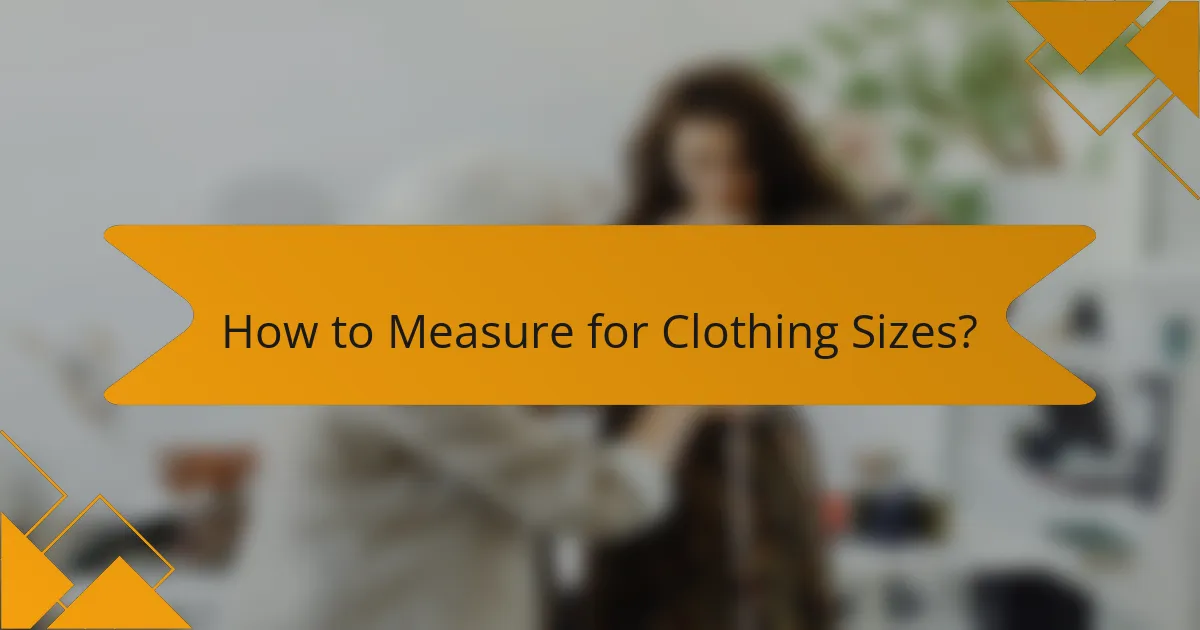
How to Measure for Clothing Sizes?
To measure for clothing sizes, use a soft measuring tape. Start by measuring the bust at the fullest part, ensuring the tape is straight across the back. Next, measure the waist at the narrowest point, usually above the belly button. Then, measure the hips at the widest part, keeping the tape parallel to the floor. For inseam, measure from the top of the inner thigh to the desired pant length. Lastly, for sleeve length, measure from the shoulder seam to the wrist. Accurate measurements ensure a better fit when selecting clothing sizes.
What are the key measurements needed for women’s clothing?
The key measurements needed for women’s clothing include bust, waist, and hip measurements. The bust measurement is taken around the fullest part of the bust. The waist measurement is taken around the natural waist, typically above the belly button. The hip measurement is taken around the fullest part of the hips. Additional measurements may include inseam, which is the length from the crotch to the ankle, and sleeve length, which measures from the shoulder to the wrist. Accurate measurements ensure a better fit and comfort in clothing. These measurements are commonly used in sizing charts across various brands.
How do you accurately measure bust, waist, and hips?
To accurately measure bust, waist, and hips, use a soft measuring tape. For the bust, wrap the tape around the fullest part of the bust, ensuring it is level and snug but not tight. For the waist, measure around the narrowest part of the waist, usually just above the belly button. For the hips, measure around the fullest part of the hips and buttocks. Make sure the tape is parallel to the ground during all measurements. It is important to stand straight and breathe normally while measuring. Accurate measurements help in selecting the right clothing sizes.
What tools are best for taking measurements?
The best tools for taking measurements are measuring tapes and rulers. Measuring tapes are flexible and can easily wrap around body contours. They provide accurate measurements for bust, waist, and hip sizes. Rulers are ideal for straight measurements on flat surfaces. They can be used for sleeve lengths and inseam lengths. Digital measuring tools are also available, offering precise readings. These tools are essential for ensuring proper fit in clothing. Accurate measurements help in selecting the right clothing sizes.
What common mistakes should be avoided when measuring?
Common mistakes to avoid when measuring include not using a flexible measuring tape. A flexible tape conforms to body contours, ensuring accurate measurements. Additionally, measuring over clothing can lead to incorrect sizes. It is best to measure over fitted clothing or directly on the skin. Another mistake is not standing straight during measurements. Good posture provides a true representation of body dimensions. Failing to take multiple measurements can also result in errors. Taking measurements at least twice helps ensure consistency. Ignoring the importance of measuring all relevant areas, such as bust, waist, and hips, can lead to ill-fitting garments. Finally, not considering the specific sizing charts of different brands can cause confusion, as sizes vary widely across manufacturers.
How can incorrect measurements lead to poor fit?
Incorrect measurements can lead to poor fit in clothing. When measurements are inaccurate, garments may be too tight or too loose. For instance, a bust measurement that is too small can cause gaping. Conversely, a waist measurement that is too large can lead to sagging. Each size has specific dimensions, and deviations from these can disrupt the intended design. A study by the American Apparel and Footwear Association shows that 70% of women wear the wrong size due to measurement errors. This highlights the importance of precise measurements for achieving a proper fit.
What tips ensure accurate and consistent measurements?
To ensure accurate and consistent measurements, use a flexible measuring tape. This tool allows for precise measurement of body contours. Always measure over undergarments for consistency. Stand straight and relaxed to avoid altering body shape during measurement. Use a mirror to check the tape’s position. Record measurements immediately to prevent forgetfulness. Take measurements multiple times for reliability. Average the results for greater accuracy. Following these steps helps achieve reliable sizing for clothing.
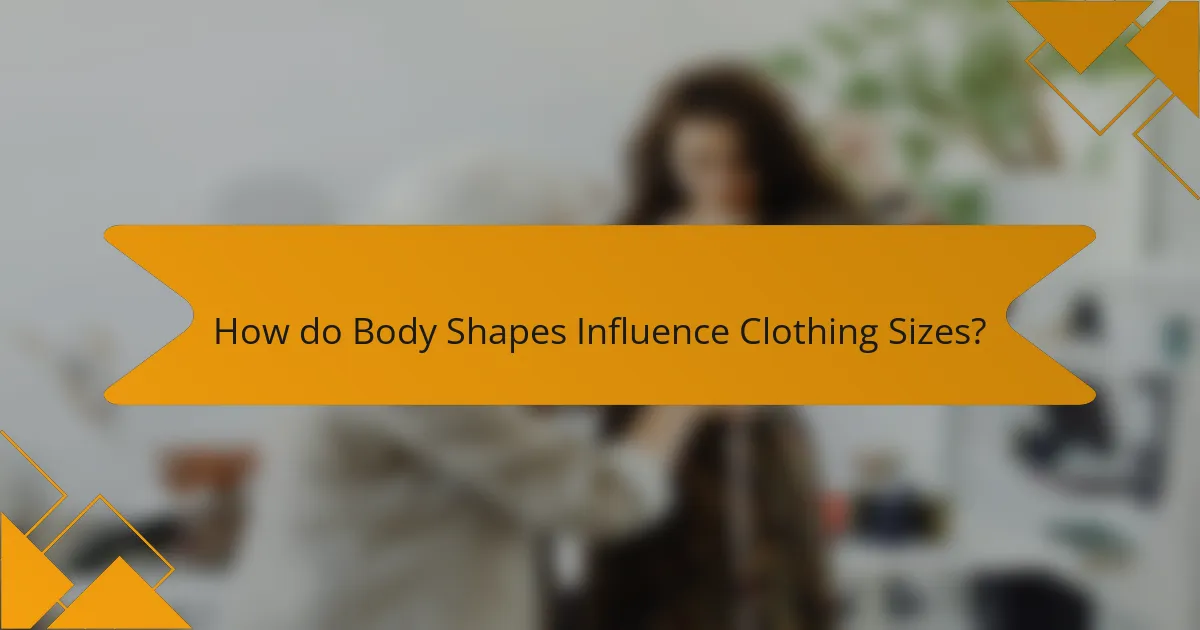
How do Body Shapes Influence Clothing Sizes?
Body shapes significantly influence clothing sizes by determining how garments fit different body types. Each body shape, such as hourglass, pear, or apple, has unique proportions that affect sizing. For instance, an hourglass figure typically requires clothing that accommodates a defined waist and balanced bust and hip measurements. In contrast, a pear-shaped body may need sizes that provide more room in the hips while fitting snugly at the waist.
The fashion industry often uses standardized sizing charts, but these do not account for individual body shapes. As a result, women with similar measurements may require different sizes based on their body shape. Studies show that approximately 80% of women wear the wrong size due to this mismatch. Understanding body shapes helps consumers select clothing that enhances their natural silhouette and provides a better fit.
What are the main body shapes women typically have?
Women typically have four main body shapes: hourglass, pear, apple, and rectangle. The hourglass shape features a defined waist with balanced bust and hip measurements. The pear shape has narrower shoulders and a wider hip measurement. The apple shape presents broader shoulders and a fuller bust with a less defined waist. The rectangle shape has similar measurements for the bust, waist, and hips, creating a straight silhouette. These classifications help in understanding fit and sizing for clothing choices.
How does each body shape affect clothing size selection?
Body shape significantly affects clothing size selection. Different body shapes, such as apple, pear, hourglass, and rectangle, require distinct sizing considerations. For example, apple shapes often need larger sizes for the bust and waist but may have smaller hips. Pear shapes typically require larger sizes for the hips and thighs while having smaller waists. Hourglass shapes usually fit well in sizes that accommodate both bust and hip measurements equally. Rectangle shapes often require sizes that provide a more tailored fit, focusing on creating curves. Understanding these variations helps in selecting the right size for comfort and style. Accurate sizing charts often reflect these differences, guiding consumers in their choices.
What styles are most flattering for different body shapes?
Different body shapes require specific styles for a flattering appearance. For hourglass shapes, fitted dresses and high-waisted skirts accentuate curves. A-line dresses are ideal for pear-shaped bodies, as they emphasize the waist while providing a balanced silhouette. Athletic body types benefit from styles that create curves, such as peplum tops and ruffled details. For apple-shaped figures, empire waist dresses help define the waistline and provide comfort. Rectangular shapes look great in wrap dresses, which create the illusion of curves. Each style choice enhances body proportions and highlights individual features effectively.
How can understanding body shapes improve shopping experiences?
Understanding body shapes can significantly enhance shopping experiences. It allows consumers to select clothing that fits well and flatters their figures. When shoppers know their body shape, they can identify styles that enhance their best features. This knowledge reduces the likelihood of purchasing ill-fitting garments. Research indicates that 67% of women feel more confident when wearing clothes that suit their body shape. Additionally, retailers can tailor their inventory based on popular body shapes, improving customer satisfaction. Overall, understanding body shapes leads to informed choices and a more enjoyable shopping experience.
What strategies can help women find their best fit?
Women can find their best fit by measuring their body accurately. Accurate measurements include bust, waist, and hip sizes. Using a flexible measuring tape ensures precision. Women should compare their measurements to size charts of specific brands. Different brands may have varying size standards. Trying on multiple styles can help identify what fits best. Considering fabric stretch and cut is essential for comfort. Seeking professional fitting assistance can provide personalized guidance. Research shows that 67% of women wear the wrong size, highlighting the importance of proper fitting.
How can body shape knowledge aid in online shopping?
Body shape knowledge aids online shopping by helping consumers select clothing that fits well. Understanding body shapes allows shoppers to identify styles that complement their figures. For instance, knowing whether one has an hourglass, pear, or apple shape can guide choices in dress cuts and silhouettes. This knowledge reduces the likelihood of returns due to poor fit. Research shows that 30% of online purchases are returned, often due to sizing issues. By using body shape information, shoppers can make more informed decisions, increasing satisfaction with their purchases.
What are some practical tips for choosing the right clothing size?
To choose the right clothing size, start by taking accurate body measurements. Measure your bust, waist, and hips using a flexible measuring tape. Compare these measurements to the sizing chart of the brand you are considering. Sizes can vary significantly between brands, so always check their specific chart. Additionally, consider the fit type you prefer, such as loose or fitted. Trying on clothing is also essential, as it allows you to assess comfort and movement. Pay attention to how the fabric stretches and feels against your skin. Lastly, read customer reviews for insights on sizing accuracy and fit.
The main entity of the article is women’s clothing sizes, which encompass various sizing systems, measurements, and fit types. The article provides an overview of how clothing sizes are determined, the essential measurements needed for accurate sizing, and the impact of body shapes on clothing selection. It discusses the significance of understanding fit types, including tailored, relaxed, and fitted styles, as well as how these fit types can enhance personal style. Additionally, the article highlights practical tips for measuring correctly, the challenges posed by sizing inconsistencies across brands, and strategies for women to find their best fit while shopping.
